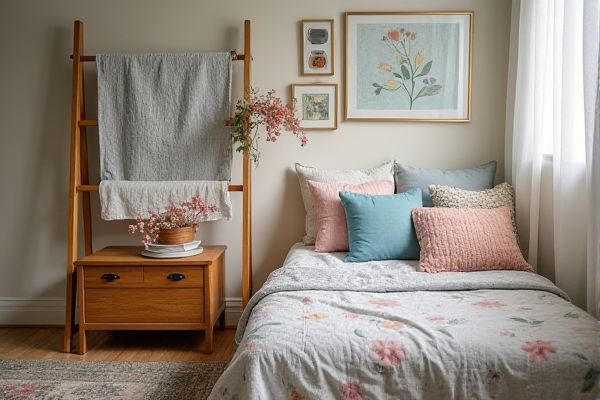
A quilt rack offers a stylish and accessible way to display and organize your quilts, while a blanket chest provides ample storage space and protects your blankets from dust and damage. Discover which option best suits Your needs by reading the rest of the article.
Table of Comparison
| Feature | Quilt Rack | Blanket Chest |
|---|---|---|
| Primary Use | Display and store quilts or blankets | Store blankets, quilts, and other linens securely |
| Design | Open frame with bars or rungs | Closed box with lid |
| Storage Capacity | Limited, mainly for few quilts | High, can hold multiple blankets or bulky items |
| Material | Wood, metal, or a combination | Typically wood, sometimes upholstered |
| Space Requirements | Vertical space, minimal floor footprint | Requires floor space, can double as seating |
| Accessibility | Easy to grab blankets; visible display | Requires opening lid to access contents |
| Style Impact | Adds decorative, rustic or traditional feel | Offers classic or vintage charm with functional storage |
| Portability | Lightweight and easy to move | Heavier and more stationary |
Introduction: Quilt Rack vs Blanket Chest
Quilt racks and blanket chests serve distinct storage and display purposes for linens. Quilt racks provide vertical hanging space that preserves fabric integrity and showcases intricate designs, while blanket chests offer enclosed, horizontal storage that protects quilts and blankets from dust and damage. Choosing between them depends on available space, aesthetic preference, and functional needs for accessibility and protection.
Key Differences Between Quilt Racks and Blanket Chests
Quilt racks are designed primarily for displaying and airing quilts with open frames that keep your fabrics visible and wrinkle-free, while blanket chests offer enclosed, spacious storage to protect blankets from dust and damage. The vertical structure of quilt racks makes them ideal for showcasing heirloom quilts or frequently used throws, whereas blanket chests often double as seating or decorative furniture, maximizing room functionality. Your choice depends on whether you prioritize easy access and display or secure, bulk storage for your bedding essentials.
Design and Style Comparison
Quilt racks typically feature an open frame design allowing your quilts to hang visibly, adding a decorative touch to any room. Blanket chests offer enclosed storage with a solid top, combining functionality with rustic or traditional style elements. Your choice depends on whether you prefer showcasing textiles or discreetly storing bulky blankets while enhancing room aesthetics.
Storage Capacity and Functionality
A quilt rack offers limited storage capacity, primarily designed to display and air out quilts or blankets, making it ideal for easy access and aesthetic appeal. In contrast, a blanket chest provides substantial enclosed storage space capable of holding multiple blankets, pillows, or linens, ensuring protection from dust and damage. Functionality-wise, the quilt rack serves as both a decorative piece and a practical organizer, while the blanket chest functions as a versatile storage solution with the added benefit of doubling as seating or a tabletop surface.
Space Requirements and Placement
A quilt rack occupies minimal floor space and can be placed in narrow areas like hallways or corners, making it ideal for small rooms or spaces where wall-mounted storage isn't possible. A blanket chest requires a larger footprint but doubles as additional seating or a coffee table, fitting well at the foot of a bed or in living rooms with ample floor area. Your choice depends on available space and how you want to integrate storage seamlessly into your room's layout.
Material Choices and Durability
Quilt racks are typically crafted from lightweight woods like pine, oak, or metal, offering easy portability but varying durability based on material quality and finish. Blanket chests commonly feature hardwoods such as cherry, walnut, or mahogany, providing robust construction and long-lasting durability ideal for heavy storage. Your choice between a quilt rack and blanket chest should consider the material's strength and how frequently you'll move or access your blankets.
Ease of Access and Organization
A quilt rack offers easy access by displaying blankets and quilts openly, allowing quick selection and minimal folding. Blanket chests provide organized storage with hidden compartments, protecting items from dust but requiring more effort to open and find specific pieces. Choosing between the two depends on whether immediate accessibility or concealed organization is a higher priority.
Decorative Appeal and Home Aesthetics
A quilt rack offers a visually appealing, open display that highlights the intricate patterns and textures of your quilts, enhancing your room's decorative charm. In contrast, a blanket chest provides a solid, streamlined look, contributing to a minimalist or traditional aesthetic while keeping your blankets neatly concealed. Your choice depends on whether you prefer showcasing vibrant textiles or maintaining a tidy, understated atmosphere in your home.
Cost and Budget Considerations
Quilt racks typically offer a more affordable and space-efficient option compared to blanket chests, making them ideal for tighter budgets or smaller rooms. Blanket chests generally require a higher upfront investment but provide valuable storage capacity for multiple blankets, bedding, or seasonal items. Your choice depends on balancing initial cost with the need for extensive storage versus simple display and accessibility.
Choosing the Best Option for Your Needs
Quilt racks provide easy access and vertical storage, ideal for displaying and airing quilts without folding, while blanket chests offer spacious, enclosed storage that protects your linens from dust and damage. Your choice depends on whether you prioritize visibility and ventilation or compact, dust-free containment. Consider the room's available space and your decor style to select the best functional and aesthetic fit.
 homyna.com
homyna.com